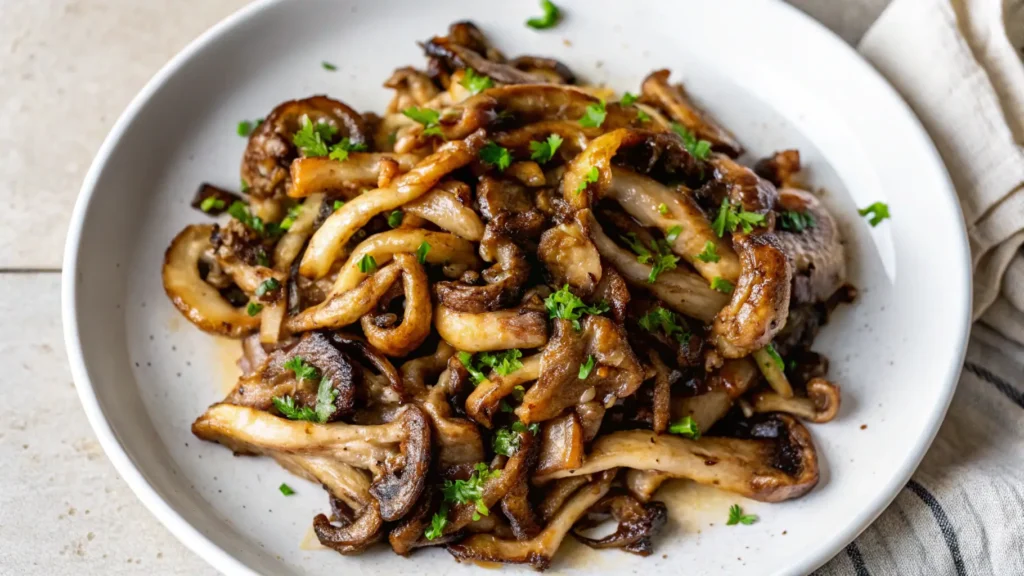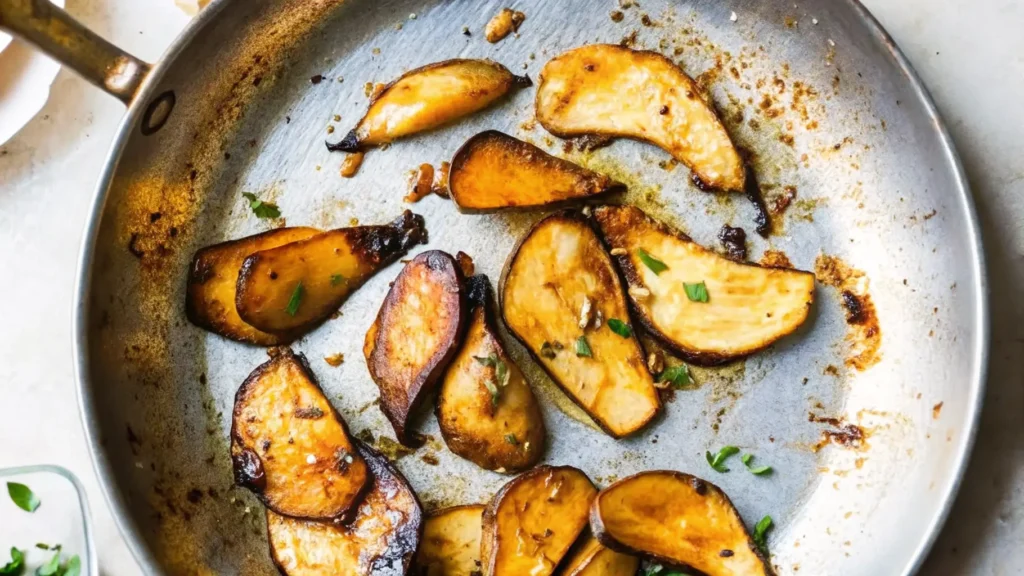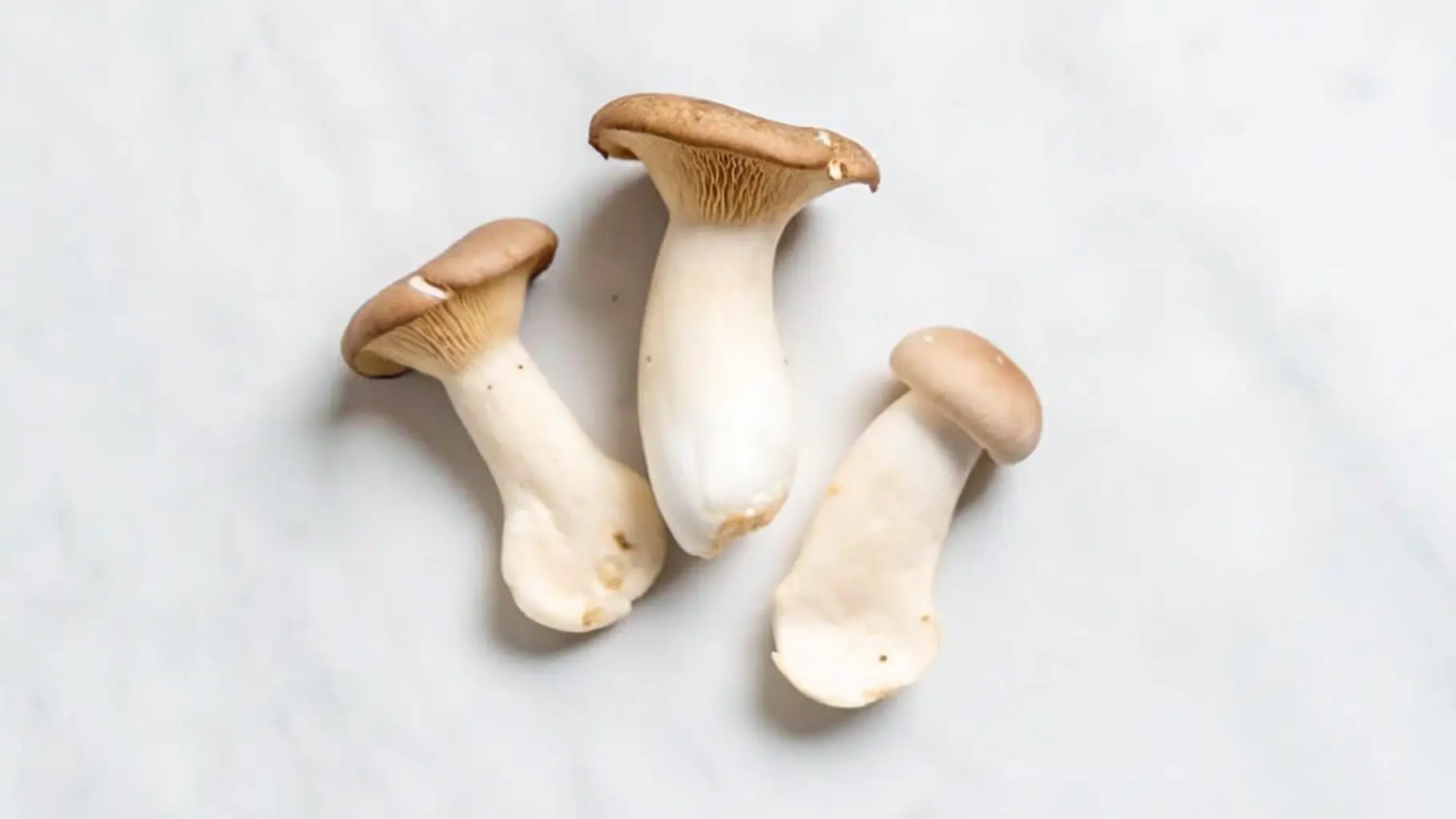Reading time: 11 minutes
You walk into a bustling farmer’s market, drawn by the rich aroma of fresh mushrooms. Among them, the king trumpet mushroom stands out—its thick stem and meaty texture hint at something special. If you’ve never tried one, you might wonder: What do king trumpets taste like? Their reputation as a gourmet ingredient suggests a unique experience, but their true flavor depends on how they’re prepared.
These mushrooms have a firm texture, making them a favorite in various cuisines. Their mild yet savory taste allows them to adapt to different cooking techniques, absorbing flavors beautifully. Whether sautéed, roasted, or grilled, they can add a new dimension to any dish. By understanding their taste profile and best cooking methods, you can make the most of these culinary gems.
Table of contents
- What Do King Trumpets Taste Like?
- Comparing King Trumpet Mushrooms to Other Varieties: Taste Differences
- How Cooking Methods Affect the Taste of King Trumpet Mushrooms
- Pairing King Trumpet Mushrooms with Complementary Ingredients
- Health Benefits and Nutritional Value of King Trumpet Mushrooms
- Culinary Uses: Incorporating King Trumpet Mushrooms into Various Dishes
- Tips for Selecting and Storing Fresh King Trumpet Mushrooms
- Common Misconceptions About the Taste of King Trumpet Mushrooms
- FAQs
- Conclusion
What Do King Trumpets Taste Like?
Unlike more common varieties, king trumpet mushrooms offer a subtly rich taste. Their flavor is mild but carries a deep, umami quality, often described as slightly nutty or earthy. Unlike button mushrooms, they don’t have a strong mushroom scent or aftertaste, making them a versatile ingredient.
When cooked, their dense texture remains firm, giving them a satisfying bite. This chewiness makes them an excellent substitute for heartier ingredients in plant-based dishes. While raw, they might taste slightly bland, but heat unlocks their natural sweetness and enhances their depth.
Some compare their taste to that of roasted nuts, while others find hints of butter or a mild seafood-like quality. Their ability to take on surrounding flavors makes them ideal for dishes that require rich, savory elements.
Comparing King Trumpet Mushrooms to Other Varieties: Taste Differences
If you’ve tried different types of mushrooms, you might wonder how king trumpet mushrooms compare. Each variety brings something unique to the table, and understanding these differences can help you choose the best one for your next dish. Here’s a quick comparison to highlight how king trumpet mushrooms stack up against others:
- Button mushrooms: These have a mild taste with a slightly grassy note. They’re commonly used in salads or basic dishes where their subtle flavor doesn’t overwhelm.
- Shiitake mushrooms: Known for their smoky, woodsy flavor, shiitakes offer a stronger umami punch than king trumpets, making them ideal for more intensely flavored dishes.
- Portobello mushrooms: With their meaty texture and deeper, earthier taste, portobellos are often used as a substitute for meat, especially in burgers, due to their substantial bite.
- Oyster mushrooms: These mushrooms are slightly sweet and delicate, with a softer texture than king trumpets, which have a firmer, more satisfying bite.
Among these, king trumpet mushrooms stand out for their remarkable firm texture and ability to absorb and enhance flavors without overpowering a dish. Their versatility makes them an excellent choice in a wide range of recipes.

How Cooking Methods Affect the Taste of King Trumpet Mushrooms
The way you prepare king trumpet mushrooms plays a significant role in their flavor profile. Their mild yet umami-rich taste allows them to adapt beautifully under heat, developing different textures and intensities depending on the cooking method. Here’s how each technique brings out unique qualities in these versatile mushrooms:
- Sautéing: A quick pan-fry with oil or butter enhances their nutty, savory notes, making them a great addition to stir-fries or as a side dish.
- Grilling: This method imparts a subtle smokiness to the mushrooms while preserving their firm texture, perfect for grilling with vegetables or using as a topping.
- Roasting: Roasting king trumpet mushrooms enhances their natural sweetness, creating a beautifully caramelized outer layer and intensifying their flavor, especially in soups or roasted veggie medleys.
- Steaming: Steaming helps preserve their delicate taste and ensures a softer, more tender texture, which works well in light, broth-based dishes.
By adjusting your cooking technique, you can highlight different aspects of king trumpet mushrooms’ flavor, making them a versatile ingredient in a wide variety of dishes.
Pairing King Trumpet Mushrooms with Complementary Ingredients
Since king trumpet mushrooms have a mild yet rich profile, they pair well with a variety of ingredients. Their ability to absorb flavors makes them an excellent addition to both simple and complex dishes. Choosing the right seasonings and complementary ingredients can enhance their natural umami while creating a well-balanced and flavorful meal. Whether you’re aiming for a savory, earthy dish or something with a hint of brightness, these mushrooms adapt effortlessly to different culinary styles.
Best Pairings:
- Garlic and onions: Bring out their savory notes and add depth to their mild taste.
- Soy sauce or tamari: Deepens their umami profile and adds a satisfying saltiness.
- Herbs like thyme or rosemary: Infuse an aromatic touch that complements their earthy flavor.
- Citrus zest: Provides a refreshing contrast, balancing their richness.
- Miso or nutritional yeast: Boosts their depth and creates a more complex, savory bite.
Whether in stir-fries, pasta dishes, or soups, these mushrooms blend well with bold and subtle flavors alike, making them a versatile ingredient in various cuisines.
Health Benefits and Nutritional Value of King Trumpet Mushrooms
Beyond taste, king trumpet mushrooms offer significant nutritional benefits. They are naturally low in calories yet packed with essential nutrients, making them a smart addition to a well-rounded diet. Their combination of vitamins, minerals, and antioxidants supports overall health while providing a satisfying, hearty texture. Whether enjoyed as a main ingredient or a flavorful side, these mushrooms contribute both taste and nourishment to your meals.
Key Nutrients:
- Protein and fiber: Aid digestion, promote gut health, and support muscle maintenance.
- B vitamins: Play a crucial role in energy production and metabolism.
- Antioxidants: Help protect cells from damage and support immune function.
- Potassium: Maintains proper heart function and regulates blood pressure.
Including king trumpet mushrooms in your meals not only enhances flavor but also boosts nutritional intake. Their firm texture and remarkable ability to absorb seasonings make them a satisfying and health-conscious choice for a variety of dishes.

Culinary Uses: Incorporating King Trumpet Mushrooms into Various Dishes
You’re in the kitchen, holding a fresh king trumpet mushroom, wondering how to make the most of its firm texture and umami flavor. Luckily, this versatile ingredient fits into many dishes, whether you prefer simple sautés or complex gourmet meals.
Popular Ways to Use King Trumpet Mushrooms:
- Sliced and sautéed: A quick pan-fry with olive oil, garlic, and a pinch of salt brings out their rich, nutty flavor.
- Grilled or roasted: Their dense texture holds up well to high heat, making them perfect for skewers or hearty sides.
- Added to soups and stews: They absorb broth flavors beautifully while maintaining a satisfying bite.
- Blended into sauces: When finely chopped, they enhance gravies and pasta sauces with a deep, savory taste.
- Shredded for plant-based recipes: Their fibrous texture mimics shredded meat in tacos or stir-fries.
Whether as a main ingredient or a flavorful addition, king trumpet mushrooms elevate any dish with their mild, umami-packed profile.
Tips for Selecting and Storing Fresh King Trumpet Mushrooms
You pick up a batch of king trumpet mushrooms at the market, excited to use them in your next meal. But how do you ensure they stay fresh and flavorful? Proper selection and storage are key to maintaining their firm texture and rich taste. By choosing high-quality mushrooms and storing them correctly, you can extend their shelf life and enjoy their unique umami flavor at its best.
How to Choose the Best King Trumpet Mushrooms:
- Look for firmness: A fresh mushroom should feel dense and solid, not soft, spongy, or shriveled.
- Check the color: The stem should be creamy white and smooth, free from dark spots, wrinkles, or signs of drying out.
- Avoid excess moisture: Mushrooms that feel slimy or overly damp have likely started to spoil and won’t last long.
Best Storage Practices:
Proper storage is essential to maintain the flavor, texture, and quality of king trumpet mushrooms.
1. Storing Fresh King Trumpet Mushrooms
- Refrigeration: Place them in a paper bag (not plastic) and store them in the refrigerator’s vegetable drawer. Paper bags help absorb excess moisture, preventing sliminess.
- Avoid Washing Before Storage: Mushrooms absorb water easily. Wash them only before cooking to prevent sogginess.
- Use Within 7-10 Days: Fresh king trumpet mushrooms last about a week when stored properly.
2. Freezing King Trumpet Mushrooms
- Blanch Before Freezing: To extend their shelf life, quickly blanch them in boiling water for 1-2 minutes, then drain and pat dry.
- Flash Freeze: Spread them out on a baking sheet and freeze for 2-3 hours before transferring them to an airtight container or freezer bag.
- Storage Life: Properly frozen king trumpets can last up to 6 months.
3. Drying for Long-Term Storage
- Use a Dehydrator: Slice mushrooms into thin pieces and dry them at 135°F (57°C) for 6-8 hours.
- Air-Drying Method: Leave sliced mushrooms in a well-ventilated area for a few days until fully dried.
- Storage: Store dried mushrooms in an airtight glass jar in a cool, dark place for up to 1 year.
4. Storing Cooked Mushrooms
- Refrigeration: Store cooked mushrooms in an airtight container for up to 3-4 days.
- Freezing: Cooked mushrooms can be frozen for up to 2 months, but their texture may soften upon thawing.

Common Misconceptions About the Taste of King Trumpet Mushrooms
If you’ve never tried king trumpet mushrooms, you may have heard mixed opinions about their flavor. Some say they taste like seafood, while others compare them to nuts or butter. But what’s the truth?
Myth #1: They Have a Strong, Overpowering Taste
Many assume these mushrooms have an intense flavor, like shiitakes. In reality, they are mild, slightly sweet, and best known for their ability to absorb seasonings.
Myth #2: They Are Spongy and Slimy
When cooked properly, king trumpet mushrooms remain firm and chewy. Their texture is closer to a well-cooked vegetable than a soft mushroom like button or oyster varieties.
Myth #3: They Taste the Same No Matter How They’re Cooked
Different cooking methods bring out different flavors. Roasting makes them slightly sweet, grilling adds a smoky depth, and sautéing enhances their nutty notes.
Understanding these facts can help you appreciate king trumpet mushrooms for what they truly offer—a unique balance of texture and taste.
FAQs
Yes, king trumpet mushrooms can be eaten raw, but they taste much better when cooked. Raw king trumpets have a mild, slightly earthy flavor and a dense, chewy texture that some people may find unappealing. Cooking enhances their umami richness and softens their texture, making them more enjoyable. If eating them raw, slice them thin and pair with acidic ingredients like lemon juice or vinegar to bring out their natural flavor.
The “best” oyster mushroom depends on personal preference and intended use:
King Trumpet Mushrooms – Best for a meaty, umami-rich taste with a firm texture.
Pearl Oyster Mushrooms – Mild and slightly sweet, great for light stir-fries.
Blue Oyster Mushrooms – Stronger umami flavor, excellent in broths or soups.
Golden Oyster Mushrooms – Delicate with a slight peppery taste, ideal for frying.
Yes and no. King trumpet mushrooms belong to the oyster mushroom family (Pleurotus eryngii), but they have a distinctly different shape, texture, and flavor compared to common oyster mushrooms (Pleurotus ostreatus). While most oyster mushrooms have thin, delicate caps and soft stems, king trumpets have thicker stems and a firmer, more meaty texture.
King trumpet mushrooms have a mild, nutty flavor with a rich umami depth. When cooked, they develop a slightly sweet, buttery taste with caramelized edges. The texture is firm and chewy, often compared to scallops, squid, or tender meat when grilled or pan-seared.
To maximize their flavor, try these tips:
Marinate them before cooking (olive oil, garlic, soy sauce, and herbs work well).
Sear them in a hot pan to create a crispy, golden crust.
Roast them at high heat for a deep, caramelized flavor.
Use butter, miso, or balsamic glaze to enhance their umami richness.
Absolutely! Their firm, meaty texture makes them an excellent plant-based alternative to meat and seafood. Many chefs use king trumpets to create vegan “scallops,” mushroom steaks, or pulled mushroom dishes.
Yes, you can eat the whole King Trumpet mushroom, including the cap and stem. The thick stem has a meaty texture, making it great for slicing, grilling, or sautéing.
No, King Trumpet mushrooms (Pleurotus eryngii) and Oyster mushrooms (Pleurotus ostreatus) are not the same. While both belong to the Pleurotus genus, King Trumpets have thick, meaty stems and a mild umami flavor, whereas Oyster mushrooms have thinner, delicate caps with a more subtle taste.
Yes, King mushrooms are fully edible and highly prized for their meaty texture and rich umami flavor. They can be grilled, sautéed, roasted, or used as a plant-based meat substitute in various dishes.
Conclusion
So, how should you think about king trumpet mushrooms? Their mild yet umami-rich flavor makes them one of the most versatile mushrooms in the kitchen. Whether grilled, sautéed, or simmered in broth, they absorb and enhance other ingredients, taking on new dimensions while maintaining their firm, satisfying bite. This unique characteristic makes them a perfect addition to a wide variety of dishes, from hearty stews to light salads.
By selecting fresh mushrooms, storing them properly, and experimenting with different cooking techniques, you can bring out their full potential and truly appreciate their flavor. If you’ve hesitated to try them before, now is the perfect time to explore how king trumpet mushrooms can elevate your meals and add an exciting, nutritious twist to your favorite recipes.
👉 Next time you see king trumpet mushrooms at the store, grab some and try them in your favorite recipes!

